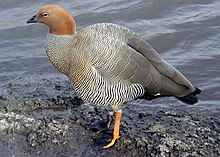
The Canada goose, or Canadian goose, is a large wild goose with a black head and neck, white cheeks, white under its chin, and a brown body. It is native to the arctic and temperate regions of North America, and it is occasionally found during migration across the Atlantic in northern Europe. It has been introduced to the United Kingdom, Ireland, Finland, Sweden, Denmark, New Zealand, Japan, Chile, Argentina, and the Falkland Islands. Like most geese, the Canada goose is primarily herbivorous and normally migratory; often found on or close to fresh water, the Canada goose is also common in brackish marshes, estuaries, and lagoons.

The black-necked swan is a species of waterfowl in tribe Cygnini of subfamily Anserinae. It is found in Argentina, Brazil, Chile, Uruguay, and the Falkland Islands.

The Andean goose is a species of waterfowl in tribe Tadornini of subfamily Anserinae. It is found in Argentina, Bolivia, Chile, and Peru.

The emperor goose, also known as the beach goose or the painted goose, is a waterfowl species in the family Anatidae, which contains the ducks, geese, and swans. It is blue-gray in color as an adult and grows to 66–71 centimetres (26–28 in) in length. Adults have a black chin and throat, a pink bill, yellow-orange legs, and a white head, which often turns reddish-brown in summer. In the winter, the emperor goose lives in mudflats and coasts in Alaska and occasionally Canada and the contiguous United States. In the summer, it migrates northerly several hundred miles to arctic and sub-arctic climates, where older individuals breed monogamously. Nests are constructed in holes and built up with vegetation and feathers. Eggs hatch in late June and early July, and goslings leave the nest the day they hatch. The species is an omnivore, and makes vocalizations that are more nasal than those of other geese. Listed as near threatened by the International Union for Conservation of Nature, the species' population is declining due to threats such as pollution, hunting, and climate change.

The ruddy shelduck, known in India as the Brahminy duck, is a member of the family Anatidae. It is a distinctive waterfowl, 58 to 70 cm in length with a wingspan of 110 to 135 cm. It has orange-brown body plumage with a paler head, while the tail and the flight feathers in the wings are black, contrasting with the white wing-coverts. It is a migratory bird, wintering in the Indian subcontinent and breeding in southeastern Europe and central Asia, though there are small resident populations in North Africa. It has a loud honking call.

The coscoroba swan is a species of waterfowl in subfamily Anserinae of the family Anatidae. It is found in Argentina, Bolivia, Brazil, Chile, Paraguay, Uruguay, and the Falkland Islands.

The ashy-headed goose is a species of waterfowl in tribe Tadornini of subfamily Anserinae. It is found in Argentina and Chile.

The Orinoco goose is a Near Threatened species of waterfowl in tribe Tadornini of subfamily Anserinae. It is found in every mainland South American country except Chile, French Guiana, Suriname, and Uruguay.
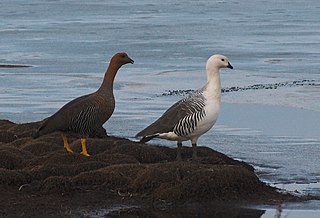
The upland goose or Magellan goose is a sheldgoose of the shelduck-sheldgoose subfamily of the Anatidae, the biological family that includes the ducks and most duck-like waterfowl such as the geese and swans. Sheldgeese resemble true geese and display similar habits, yet they are more closely related to shelducks and ducks. The two recognized subspecies of upland goose are the continental picta subspecies and the insular (island) leucoptera subspecies.

The kelp goose is a species of waterfowl in tribe Tadornini of subfamily Anserinae. It is found in Argentina, Chile, and the Falkland Islands.

The flying steamer duck, also known as the flying steamer-duck or flying steamerduck, is a species of South American duck in the family Anatidae.

The Fuegian steamer duck or the Magellanic flightless steamer duck, is a flightless duck native to South America. It belongs to the steamer duck genus Tachyeres. It inhabits the rocky coasts and coastal islands from southern Chile and Chiloé to Tierra del Fuego, switching to the adjacent sheltered bays and lakes further inland when breeding.

Chloephaga is a genus of sheldgeese in the family Anatidae. Other sheldgeese are found in the genera Alopochen and Neochen.
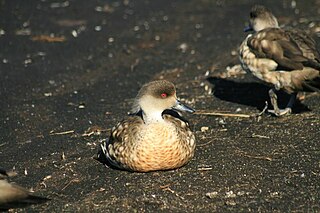
The crested duck or South American crested duck is a species of duck native to South America, the belonging to the monotypic genus Lophonetta. It is sometimes included in Anas, but it belongs to a South American clade that diverged early in dabbling duck evolution. There are two subspecies: L. specularioides alticola and L. specularioides specularioides. The Patagonian crested duck is also called the southern crested duck and its range lies in the Falklands, Chile, and Argentina.
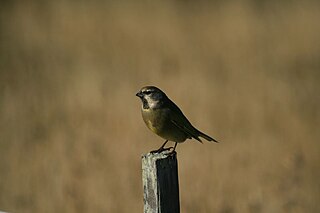
The white-bridled finch, also known as the canary-winged finch or black-throated finch, is a small passerine bird belonging to the genus Melanodera together with the yellow-bridled finch. Formerly placed in the family Emberizidae, it is now considered a tanager. It is found in grassland in southernmost South America. There are two subspecies: M. m. melanodera in the Falkland Islands and M. m. princetoniana in southern Argentina and Chile.
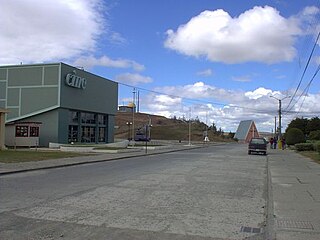
Cerro Sombrero is a village in southern Chile. It is located in the Primavera commune in the Magallanes Region, in the northern part of Tierra del Fuego, about 125 km from Porvenir. According to the 2002 census, it had 687 inhabitants.

The Magellanic oystercatcher is a species of wader in the family Haematopodidae. It is found in Argentina, Chile and the Falkland Islands in freshwater lake and sandy shore habitats.

The Patagonian mockingbird is a species of bird in the family Mimidae. It is found in much of Argentina and locally in Chile.

The Memorandum of Understanding (MoU) concerning Conservation Measures for the Ruddy-headed Goose is a Bilateral Environmental Memorandum of Understanding between Argentina and Chile and was concluded under the auspices of the Convention on Migratory Species of Wild Animals (CMS), also known as the Bonn Convention. The MoU was concluded as part of the Special Protocol on the Conservation of Wild Fauna and Flora, signed by Argentina and Chile in 2002, and entered into effect on 21 November 2006. It focuses on the protection of the mainland population of the ruddy-headed goose. The MoU is exclusively South American and covers two range States, both of which have signed.

The Patagonian grasslands (NT0804) is an ecoregion in the south of Chile, Argentina and the Falkland Islands. The grasslands are home to diverse fauna, including several rare or endemic species of birds. There are few protected areas. The grasslands are threatened by overgrazing by sheep, which supply high-quality merino wool. Efforts are being made to develop sustainable grazing practices to avoid desertification.
